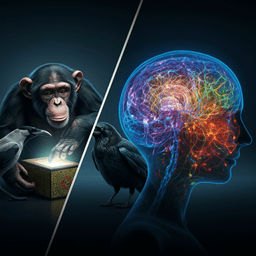
Psychology
Curiosity: The Effects of Feedback and Confidence on the Desire to Know
J. Metcalfe, M. Vuorre, et al.
Across 10 experiments, different feedback types (yes/no, true/false informational, or none) shifted people’s curiosity: yes/no feedback blunted curiosity for correct answers but amplified it for discovered errors, especially high-confidence errors; other feedback patterns supported the “almost knowing” region of proximal learning. Research conducted by Janet Metcalfe, Matti Vuorre, Emily Towner, and Teal S. Eich.
~3 min • Beginner • English
Introduction
The paper examines how feedback shapes epistemic curiosity (Curiosity1) about specific answers, focusing on the Region of Proximal Learning (RPL) framework. RPL posits that curiosity peaks when people feel they almost know an answer and is quenched when certainty is high. The authors contrast definitive yes/no feedback (hard boundary between known and unknown) with informational feedback under uncertainty (soft boundary), and investigate how confidence in one's initial answer interacts with feedback type to modulate curiosity. They also explore whether curiosity judgments tap metacognitive signals beyond confidence, such as conflict monitoring, and whether curiosity differs for high-confidence errors versus equally high-confidence correct responses.
Literature Review
Foundational theories suggest curiosity is highest for items that are neither too easy nor too hard (Berlyne, 1954; Atkinson, 1972; Loewenstein, 1994). The RPL framework (Metcalfe & Kornell, 2003, 2005; Metcalfe et al., 2020) and related findings show people preferentially study material they almost know, improving learning, with parallels in feeling-of-knowing and tip-of-the-tongue (TOT) phenomena (Schwartz, 1999; Metcalfe et al., 2017; Bloom et al., 2018). Curiosity depends on metacognition—awareness of what one knows and does not know (Loewenstein, 2007), and once an answer is known, curiosity is satiated (Berlyne, 1954). High-confidence errors share properties with TOT: they carry partial, near-correct information and elicit hypercorrection and enhanced encoding (Butterfield & Metcalfe, 2001, 2006; Metcalfe & Finn, 2011, 2012; Sitzman et al., 2014, 2015; Bloom et al., 2018). Prior work on curiosity and errors is limited and mixed (Wade & Kidd, 2019; Fastrich et al., 2018). The authors also reference theories linking curiosity to uncertainty reduction and prediction error (Friston et al., 2017; Gottlieb et al., 2013; Murayama et al., 2019), and metacognitive models emphasizing fluency and confidence (Koriat, 1993, 2008a, 2008b, 2012; Kelley & Lindsay, 1993).
Methodology
Across 10 experiments (including a pilot and a no-feedback control), participants answered general information questions, rated confidence (0–100), and provided curiosity or second-order metacognitive ratings; feedback manipulations varied by experiment. Analyses used Bayesian multilevel regression (brms in R; Bürkner, 2017), with random effects for participants and items, linear and quadratic confidence terms, and model comparison via WAIC.
- Experiment 1 (N=44): 90 questions; answer, confidence; yes/no feedback; if incorrect, rate curiosity. Examined curiosity vs. confidence on errors after being told wrong.
- Experiment 2 (N=80) + Pilot (N=72): 128 questions; within-subjects yes/no feedback vs. no feedback; curiosity after feedback or no feedback; subsequent study/test phase on no-feedback items (high- vs low-curiosity selection). Balanced/imbalanced feedback in pilot noted.
- Experiment 3 (N=48, online): 64 questions; answer, confidence; no feedback; second-order metacognition: surprise-if-wrong rating (converted to subjective uncertainty = 100 − surprise).
- Experiment 4 (N=98, online): Between-subjects; 64 questions; answer, confidence; then either subjective uncertainty or curiosity (no feedback) to directly compare judgment types.
- Control (No Feedback) (N=50): Procedure like Exp. 5/8 curiosity collection without feedback to form baseline.
- Experiment 5 (N=50): True informational feedback under uncertainty (show correct answer as if from another participant) immediately after confidence; then curiosity.
- Experiment 6 (N=48): Same as Exp. 5 but rating belief that the other participant’s (true) answer is correct; included a few false-feedback trials to avoid ceiling inference; analyzed only true-feedback trials.
- Experiment 7 (N=54): Same as Exp. 5 but asked how certain they now knew the correct answer after true but uncertain feedback.
- Experiment 8 (N=46): False but plausible feedback under uncertainty (from another participant) after confidence; curiosity; error trials split by whether false feedback matched vs mismatched the participant’s error.
- Experiment 9 (N=48): Mixed feedback; analyzed belief in false feedback under uncertainty.
- Experiment 10 (N=46): Assessed certainty that participants now knew the answer after false feedback.
All experiments used general-information questions (Nelson & Narens, 1980; Bloom et al., 2018). Some experiments were conducted online (Gorilla; bot check). Data cleaning included hand-checking accuracy to remove trivial spelling/format issues. Confidence, curiosity, and belief/judgment ratings used 0–100 sliding scales.
Key Findings
Yes/No feedback (hard boundary):
- Exp. 1: When told an answer was wrong, curiosity increased with confidence in the error (bLinear=.24, SE=.04, 95% CI [.16,.32], pd>99.9%), quadratic ns.
- Exp. 2: For correct answers, yes/no feedback sated curiosity to near-zero (intercept≈8.97, SE=2.50). Without feedback, curiosity for correct responses showed an inverted-U, decreasing with higher confidence (bLinear=−.27, SE=.04; bQuadratic=−.31, SE=.03; both pd>99.9%). For errors, yes/no feedback selectively increased curiosity for high-confidence errors (difference at confidence=90: 17.28, SE=3.16, 95% CI [11.14, 23.5], pd=100%). Memory: studying high-curiosity items improved recall (M=.81 vs .63; t[59]=4.64, p<.001).
Serendipitous result (replicated in pilot, control, Exp. 4):
- No-feedback condition: High-confidence errors elicited greater curiosity than equally high-confidence correct answers (Exp. 2 difference at confidence=90: 14.69, SE=2.56; pilot: 23.39, SE=5.73; control: 11.94, SE=2.48; all pd>99.9%).
Subjective uncertainty vs curiosity:
- Exp. 3 & 4: Subjective uncertainty decreased near-linearly with confidence for both correct and incorrect responses, whereas curiosity showed an inverted-U and differentiated high-confidence errors from high-confidence correct answers. In Exp. 4, linear trends differed strongly between uncertainty and curiosity (DifferenceLinear=−.63, SE=.07, pd>99.9%). At high confidence, curiosity (but not uncertainty) was greater for errors than corrects (Difference at 90: 7.22, SE=2.33, pd=99.9%).
True feedback under uncertainty (soft boundary):
- Exp. 5: Providing the correct answer (as if from another participant) slightly increased curiosity for high-confidence errors (linear slope difference .14, SE=.07, pd=97.8%), with little change for correct answers.
- Exp. 6: Belief in true feedback depended on participants’ own accuracy; belief was high for high-confidence corrects and remained moderate even when participants had made high-confidence errors (bAccuracy=−10.66, SE=.98, pd>99.9%).
- Exp. 7: Feeling of knowing after true feedback: For correct responses, certainty increased but often did not reach ceiling except at very highest confidence (bIntercept≈84.71; bLinear=.21, both pd>99.9%). For errors, certainty that they now knew decreased for high-confidence errors (bIntercept≈29.90; bLinear=.34).
False feedback under uncertainty:
- Exp. 8: False feedback increased curiosity for high-confidence correct responses (difference in linear slopes .26, SE=.08, pd=99.9%; post hoc at confidence=90: 12.46, SE=5.17, pd=99.2%). Overall effects on errors were minimal, but when false feedback mismatched a participant’s own high-confidence error, curiosity increased more than when it matched (linear difference .11, SE=.04, pd=99.8%).
- Exp. 9: Belief in false feedback was lower when participants had been correct (bAccuracy=7.79, SE=1.16, pd>99.9%), and for correct answers belief decreased with increasing confidence (interaction .19, SE=.04, pd>99.9%).
- Exp. 10: False feedback had little impact on participants’ belief that they now knew the answer; post-feedback certainty tracked initial confidence for both correct and incorrect responses (bLinear=.64, SE=.07, pd>99.9%).
Overall: Definitive confirmation of correctness extinguished curiosity; manipulations that undermined certainty (especially for high-confidence responses) increased curiosity, aligning with the RPL model. Curiosity judgments differed from subjective uncertainty/prediction error and appeared to be sensitive to conflict between one’s answer and feedback.
Discussion
Findings support the RPL model: curiosity is minimal when certainty of knowing is high and maximal when answers feel almost known. Yes/no feedback imposes a hard boundary; definitive confirmation quenches curiosity for correct answers, while being told one was wrong raises curiosity for high-confidence errors. Under uncertain informational feedback (soft boundary), merely providing answers does not extinguish curiosity because participants remain unsure whether they know; true feedback slightly increases curiosity for high-confidence errors, and false feedback notably increases curiosity for high-confidence corrects by undermining certainty. Curiosity judgments diverged markedly from subjective uncertainty ratings, suggesting they tap additional metacognitive signals, likely related to conflict monitoring or a “tell” that something might be amiss. The replicated finding that, without feedback, curiosity is higher for high-confidence errors than for equally high-confidence correct responses indicates that curiosity may be especially sensitive to discrepancies that confidence judgments ignore, consistent with theories implicating anterior cingulate cortex and conflict monitoring in curiosity. These dynamics have implications for information environments: discrepant information (even false) can trigger curiosity, with potential benefits for error correction and risks for misinformation engagement.
Conclusion
Across 10 experiments, curiosity was largely governed by perceived proximity to knowing and certainty. Definitive yes/no feedback sated curiosity for correct answers and increased it for high-confidence errors. Under uncertain feedback, true information slightly increased curiosity for high-confidence errors, and false information increased curiosity for high-confidence correct answers. Curiosity judgments were not equivalent to subjective uncertainty or prediction error estimates; they appeared more sensitive to conflict and potential discrepancy. A robust, replicated result was greater curiosity for high-confidence errors than for equally high-confidence correct responses in no-feedback contexts. Future work should examine the role of source credibility, repetition, social identity cues, and neural mechanisms of conflict and curiosity; explore how curiosity can be harnessed to improve learning and error correction; and investigate how false or discrepant information in digital media may exploit curiosity.
Limitations
Feedback sources were presented as another (unauthorized) participant, potentially limiting generalizability; effects might differ with highly credible or socially salient sources. Some experiments were conducted online due to COVID-19, with self-paced ratings and general-information questions, which may constrain ecological validity. Several effects under uncertain feedback were small. The study was not preregistered. In Experiment 2’s pilot, feedback was imbalanced across trials. Curiosity and metacognitive judgments relied on subjective rating scales, and the sample was primarily young adults.
Related Publications
Explore these studies to deepen your understanding of the subject.







